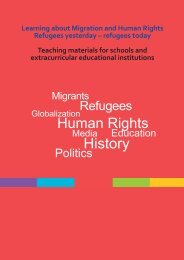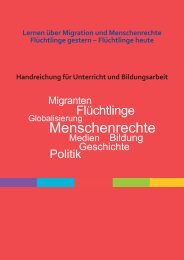IMMIGRATION IN ITALY By Laura Zanfrini* 1. From a source to a ...
IMMIGRATION IN ITALY By Laura Zanfrini* 1. From a source to a ...
IMMIGRATION IN ITALY By Laura Zanfrini* 1. From a source to a ...
- No tags were found...
Create successful ePaper yourself
Turn your PDF publications into a flip-book with our unique Google optimized e-Paper software.
distinction, transversely <strong>to</strong> geographical coordinates, between large metropolitan provinces, such asRome, Milan, but also Naples, Palermo and Bari, and the so-called “minor provinces”. While theformer stand out because of relatively higher immigrants’ irregularity and density rates, the lattergive sometimes the impression that the phenomenon of migrations takes “second place”, with lowerirregularity levels and greater signals of taking root in the terri<strong>to</strong>ry and in local communities.As far as the single nationalities are concerned, the change in the structure of the foreignpopulation by nationality clearly confirms Italy’s status as an immigration country in which flowsare diversifying and are not just linked <strong>to</strong> a few countries: the number of sending countries is huge(around 200) and many of them are very distant and have never had economic or culturalrelationships with Italy. Nowadays, the largest foreign group is the Romanian (more than onemillion), followed by the Moroccan and the Albanian ones (both around half a million), by theChinese, Ukrainian and Filipino ones. Nevertheless, as it is clearly demonstrated by data reported inTable 1, the composition of the migrants’ presence in Italy has been repeatedly changing duringtime, augmenting the incidence of the European sending countries.Tab. 1 – Foreigners residents in Italy. First ten nationalities (only heavy migration pressure countries) and <strong>to</strong>tal.Years 1971-20111971* 1981* 1991* 2001* 2011**Yugoslavia 6,460 Iran 8,399 Morocco 63,809 Morocco 162,254 Romania 1,110,848Argentina 2,068 Yugoslavia 6,472 Tunisia 31,881 Albania 146,321 Albania 515,808Iran 1,752 Philippines 4,107 Philippines 26,166 Romania 69,999 Morocco 484,288Poland 1,504 Ethiopia 4,048 Yugoslavia 22,335 Philippines 65,073 China 231,199Venezuela 1,477 Egypt 3,139 Senegal 21,073 China 60,143 Ukraine 209,575Brazil 1,406 India 2,535 Egypt 14,183 Tunisia 45,972 Philippines 142,906India 1,057 Jordan 2,411 China 12,998 Yugoslavia 40,151 Moldova 136,675Syria 975 Cape Verde 2,168 Poland 10,933 Senegal 39,170 India 131,001Turkey 930 Libya 2,080 Brazil 9,364 Sri Lanka 33,789 Poland 125,110Libya 860 Argentina 2,018 Sri Lanka 8,747 Egypt 32,381 Tunisia 113,251Total 143,838 Total 198,483 Total 548,193 Total 1,379,749 Total 4,744,290* Data reported refer <strong>to</strong> the number of foreigners possessing a valid permit of stay.** Data reported refer <strong>to</strong> an estimation made by ISMU Foundation of foreigners regularly living in Italy.Source: Interior Ministry for the years 1971-2001; ISMU Foundation for the year 201<strong>1.</strong>The increase of the permanently settled immigrant population is responsible for therebalancing in the gender composition of different national groups; for the growth of the share ofthe foreign population under the age of 18; for the considerable increase of the numbers ofmarriages and above all for foreign citizens births.Even if the gender composition of the different national groups shows the variety ofmigra<strong>to</strong>ry models (with the two extremes, among the major communities, represented by Senegal,with 75.6% of males and Ukraine, with 79.8% of females), as the years go by we can observe a rebalancingtrend. In general terms a good equilibrium was already notable in 1997: males constituted55.2% and females 44.8% of the <strong>to</strong>tal number of foreigners present in Italy. In 2002, a completebalance was almost reached, with males constituting less than 52% of the <strong>to</strong>tal.An other interesting phenomena is represented by demographic events. Marriages in whichone or both persons were foreign accounted for 13% (26,617, among those the majority – 14,799 –is represented by the unions of an Italian man with a foreign woman) of all marriages contracted in2011 (but the divorce rate for marriages involving foreigners was twice as high).In the second half of the 1980s the proportion of foreign children born in Italy was only<strong>1.</strong>1% of the <strong>to</strong>tal number of births; this proportion has reached 4.5% in 1996, 9.4% in 2006 and14.5% in 2011: this figure is probably the most important indica<strong>to</strong>r that a significant proportion offoreigners is in the process of settlement on a permanent basis. In 2011, 105,975 new births (19.4%of the <strong>to</strong>tal new births) had at least one foreign parent; 21,213 an Italian father and a foreign motherand 5,501 an Italian mother and a foreign father.<strong>Laura</strong> Zanfrini, Immigration in Italy, June 30, 2013. 2







